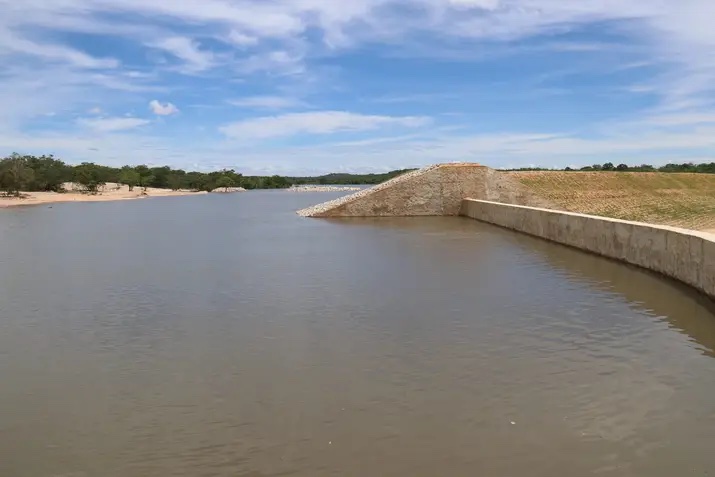
Bishop Rudolf Nyandoro of the Catholic Diocese of Gweru in Zimbabwe inspects the Holy Cross Dam in a February 2024 photo. (Courtesy of the Diocese of Gweru)
A Catholic diocese in Zimbabwe has rebuilt its own dam as part of faith-based responses to water challenges brought by climate change.
The Diocese of Gweru in the country's low rainfall Midlands province says the Holy Cross Dam, reconstructed at the beginning of this year, will go a long way toward reviving long abandoned agriculture projects.
The dam is also expected to create a greenbelt for local farming communities and drive other downstream economic activities to help support long-term sustainable development.
Gweru is in Midlands, one of the country's 10 provinces that have in recent years experienced below average rainfall, sending agriculture production into a tailspin that has left thousands of households threatened by hunger.
The construction of the Gweru Diocese dam comes at a time when the Catholic international aid agency Caritas is also helping rural communities with the rehabilitation of a defunct dam as part of efforts to cushion against climate-induced water stress.
The government has touted more dam rehabilitation and dam construction as the answer to escalated food production after successive poor harvests due to below normal rainfall.
The government sees dams as a way to power the country's vast irrigation infrastructure, with the minister of finance Mthuli Ncube telling state media, "When it comes to investment in irrigation, we are going to accelerate investments now that we have the water bodies. We have to impound water. So, it's an ongoing program to complete dams under construction."
The government says so far that 12 large dams are under construction across the country, with the aim to have about 350,000 hectares (about 864,869 acres) of land under irrigation by 2025.
The Gweru Catholic Diocese has responded to those government goals by funding its own dam reconstruction.

The Diocese of Gweru in Zimbabwe has rebuilt its own dam as part of faith-based responses to water challenges brought by climate change. The Holy Cross Dam is pictured in a February 2024 photo. (Courtesy of the Diocese of Gweru)
"[The dam] was damaged by floods in 2008. The dam was the source of livelihood for the whole community as there was irrigation for the community, but it was no longer functional," said Fr. Kudakwashe Musvevereki, the Gweru Diocese pastoral director.
"The reconstructed dam is going to support irrigation for the community and there is also going to be fishery projects. People's livestock will also get water from the dam," Musvevereki told EarthBeat.
The Holy Cross Dam is one of many such projects being undertaken by the Catholic Church across the country as a direct response to climate change and the desire to boost food production among low-income communities.
However, researchers say while new dams are needed, the long-term effects of such projects amid poor rainfall runoff must be taken into consideration.
"Dams can indeed cushion against climate change. But in the context of Zimbabwe, can they be effective in cushioning the population?" said Munyayiwashe Shumba, a Zimbabwean researcher at the University of Warsaw, Poland, whose focus includes climate change and conflict.
"Climate change is here, erratic rain is already being experienced, but when will the number of dams needed be constructed?" Shumba asked, as Zimbabwe's proposed multi-million-dollar dam construction projects have been slowed by funding challenges.
Advertisement
The construction of large hydropower dams has been contentious across the globe with environmentalists raising concerns about their impact.
"The construction of more dams means a disturbance of the natural environment which impacts negatively on climate in the long term, such as the destruction of trees. There are also increased risks of flooding during and after construction that disturbs the natural environment," Shumba told EarthBeat.
For the Gweru Catholic Diocese however, the small Holy Cross Dam is a call to faith.
"The construction of the dam is a response to the message from the Holy Father in Laudato Si'. Already the vegetation around the dam has changed and wetlands around the dam are being revived," Musvevereki said.
As Zimbabwe pursues more interventions to address the challenges of climate change in the food production value chain, and with the active participation of the Catholic Church, the authorities are betting that the country will return to its former status as a regional breadbasket.
In a recent public address to mark Harare Archbishop Robert Ndlovu's episcopal silver jubilee, Zimbabwe's President Emmerson Mnangagwa expressed government appreciation for the contributions being made by the Catholic Church toward the country's socioeconomic development.








